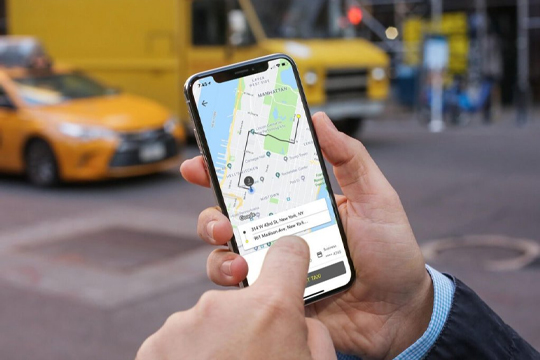From ordering food to hailing a ride, on-demand services have revolutionized how we live, work, and commute. At the forefront of this revolution stands Uber, a name synonymous with instant, reliable transportation. Have you ever dreamt of creating an app that mirrors Uber’s success, perhaps tailored for a niche market or with unique features that address local needs? You’re not alone! The global mobile app development market is booming, with mobile app revenue expected to reach an astounding $613 billion in 2025. This makes it an opportune time to embark on your own ride-sharing app journey.
Building an app as sophisticated as Uber might seem like a monumental task, but with a clear roadmap and the right development partner, it’s an achievable goal. This comprehensive guide will walk you through the essential steps, delve into the crucial cost breakdown for 2025, and highlight how a seasoned expert like Ndimension Labs can transform your vision into a thriving reality.
Uber-like App Development Roadmap

Understanding the Core: What Makes an Uber-like App Tick?
Before diving into the “how,” let’s understand the fundamental components that power a successful ride-sharing application. At its heart, an Uber-like app is comprised of three distinct yet interconnected applications:
- Passenger App: This is the user-facing interface, designed for seamless ride booking, tracking, and payment.
- Driver App: Tailored for drivers, this app facilitates ride acceptance, navigation, and earnings management.
- Admin Panel: The control center for your
business, enabling you to manage users, drivers, rides, payments, and analytics.
Uber-like App Ecosystem
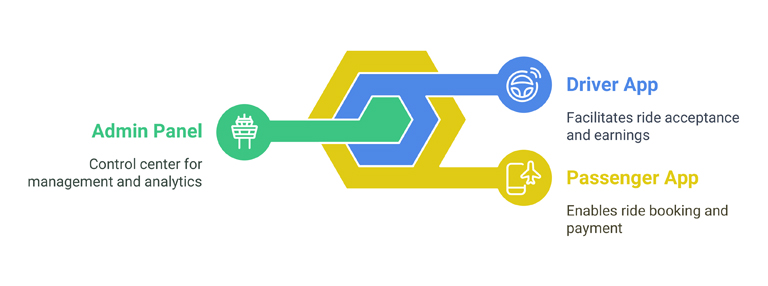
The synergy between these three elements, powered by robust backend infrastructure and sophisticated algorithms, is what delivers the seamless experience users have come to expect.
Step-by-Step Guide to Building Your Uber-like App
Building a ride-sharing app is an intricate process that requires careful planning and execution. Here’s a detailed breakdown of the key stages:
Step 1: Market Research and Niche Identification (The “Why” Before the “What”)
Before a single line of code is written, thorough market research is paramount. The
ride-sharing market is competitive. Identifying a unique selling proposition (USP) is crucial. Ask yourself:
- Who is your target audience? (e.g., corporate commuters, tourists, specific age groups)
- What problems are you solving for them? (e.g., lack of reliable transport in a specific area, need for luxury rides, eco-friendly options)
- Who are your competitors, and what are their strengths and weaknesses?
- What makes your app different and better? This initial phase helps define your app’s core value and target market, ensuring you’re building something people genuinely need.
Step 2: Feature Definition and User Experience (UX/UI) Design
Once your niche is clear, it’s time to outline the features that will bring your vision to life. A basic Uber-like app MVP (Minimum Viable Product) should include:
For the Passenger App:
- User Registration & Profile Management: Easy sign-up, profile
- Geolocation & Map Integration: Real-time location tracking, destination
- Ride Booking & Scheduling: Instant booking, scheduled
- Fare Estimation: Transparent pricing before
- Multiple Payment Options: Credit/debit cards, mobile wallets,
- Real-time Ride Tracking: See the driver’s location on the
- Push Notifications: Updates on ride status, driver
- Ride History & Receipts: Access to past rides and payment
- Rating and Review System: Rate drivers and provide
- Customer Support: In-app chat or call
Ride-hailing app features
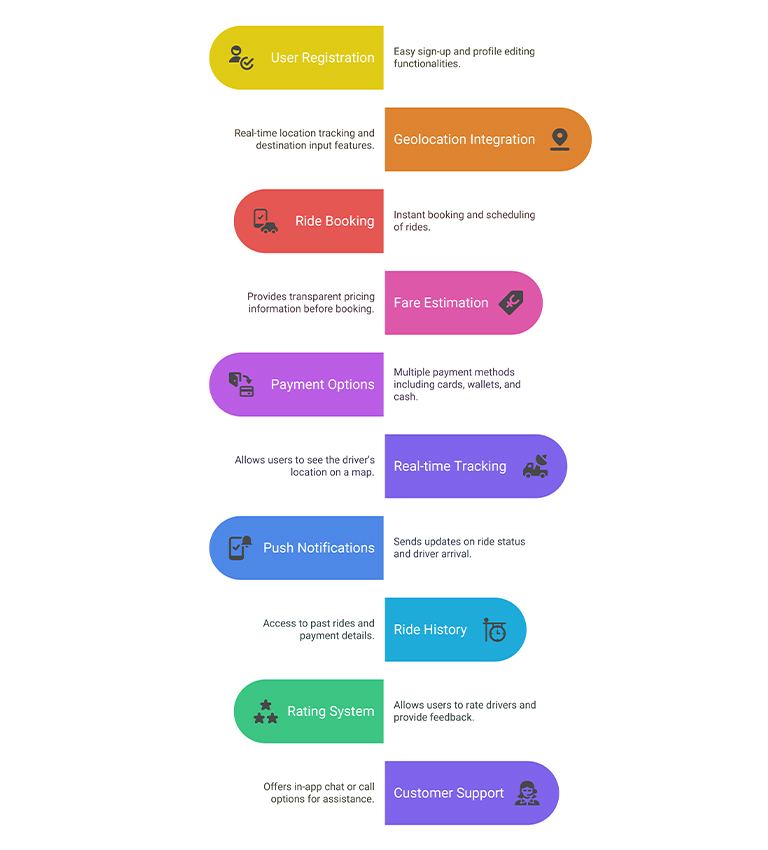
For the Driver App:
- Driver Registration & Profile (with verification): Documents upload, background
- Ride Request Management: Accept/decline
- Navigation & Route Optimization: GPS-guided
- Earnings Tracking: Detailed reports of trips and
- Availability Toggle: Go online/offline.
- Push Notifications: New ride requests, payment
- Rating and Review System: Rate
Driver App Features
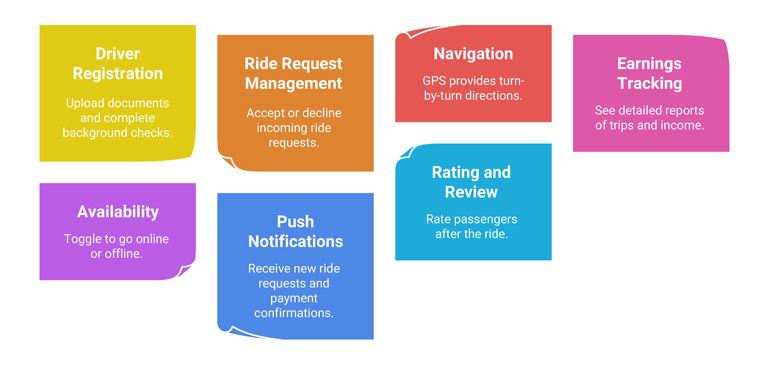
For the Admin Panel:
- User & Driver Management: Onboarding, blocking, profile
- Ride Management: Monitor active rides, resolve
- Payment & Commission Management: Track transactions, set commission
- Analytics & Reporting: Insights into business performance, popular routes, peak
- Customer Support Management: Oversee and resolve user
Admin Panel Functions for Ride-Sharing App

Beyond the MVP: Consider advanced features for future phases, such as in-app messaging between driver and passenger, multiple drop-off points, ride-sharing (pooling), panic buttons, surge pricing, promotional codes, and AI-driven dynamic pricing.
UX/UI Design: This is where your app truly shines. An intuitive, visually appealing, and easy-to-navigate interface is crucial for user adoption and retention. Remember, 88% of mobile time is spent in apps, not browsers, emphasizing the importance of a compelling app experience. A well-designed UI/UX can significantly impact user engagement and satisfaction.
Step 3: Technology Stack Selection
Choosing the right technology stack is a critical decision that impacts scalability, performance, and future maintenance. For an Uber-like app, key technologies include:
- Mobile App Development:
- Native (iOS: Swift/Objective-C; Android: Java/Kotlin): Offers the best performance, security, and access to device features.
- Cross-platform (React Native, Flutter): Faster development, single codebase for both platforms, potentially lower initial cost. However, may have some limitations compared to native.
- Backend: js, Python, Ruby on Rails, Java.
- Database: PostgreSQL, MongoDB, MySQL,
- Mapping & Location Services: Google Maps API, Mapbox, HERE
- Payment Gateways: Stripe, PayPal, Braintree, local payment
- Real-time Communication: WebSockets,
- Cloud Hosting: AWS, Google Cloud Platform,
Software Development Technologies
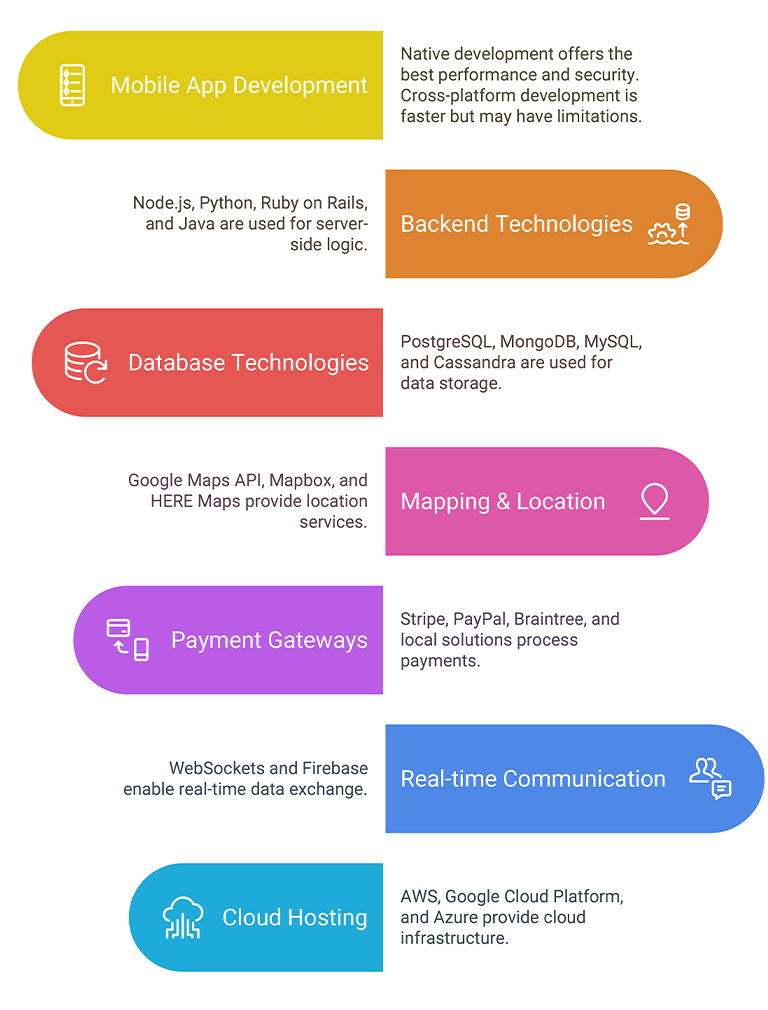
Step 4: Development and Testing
This is the core coding phase. It’s often broken down into sprints if an Agile methodology is used, allowing for iterative development and continuous feedback.
- Backend Development: Building the server-side logic, APIs, and database This is the “engine” of your app.
- Frontend Development: Building the user and driver applications for chosen platforms (iOS/Android).
- API Integrations: Connecting third-party services like payment gateways, mapping services, and SMS
- Quality Assurance (QA) and Testing: Rigorous testing is essential to identify and fix bugs, ensure smooth functionality, and deliver a high-quality app. This includes functional testing, performance testing, security testing, and user acceptance testing.
Step 5: Deployment and Launch
Once tested and refined, your app is ready for deployment to the respective app stores (Apple App Store and Google Play Store). This involves preparing app store listings, screenshots, and descriptions that attract users. A strategic marketing plan is vital for a successful launch and user acquisition.
Step 6: Post-Launch Support & Maintenance
Launching your app is just the beginning. Ongoing maintenance, bug fixes, feature updates, and performance monitoring are crucial for long-term success and user retention. This also includes scaling your infrastructure as your user base grows.
Cost Breakdown for Building an Uber-like App in 2025
The cost of developing an app like Uber can vary significantly based on several factors, including:
- Feature Complexity: More features mean more development time and
- Platform Choice: Native vs. cross-platform development. Building for both iOS and Android generally costs more than a single platform.
- Design Complexity (UI/UX): Custom, high-end designs cost more than template-based solutions.
- Development Team Location: Hourly rates vary drastically across regions (e.g., North America vs. India).
- Team Size & Expertise: Experienced developers command higher
- Third-Party Integrations: Costs associated with APIs for maps, payments, SMS,
- Post-launch Maintenance: Ongoing expenses for updates, bug fixes, and server costs. Here’s an estimated cost breakdown for building an Uber-like app in 2025, focusing on a robust, feature-rich solution:
- Discovery & Planning (10-15% of total cost): ~$6,000 – $22,500
- UI/UX Design (15-20% of total cost): ~$9,000 – $30,000
- Frontend Development (Passenger & Driver Apps) (30-40% of total cost):
- Passenger App (iOS & Android): ~$30,000 – $70,000
- Driver App (iOS & Android): ~$25,000 – $65,000
- Backend Infrastructure & API Development (20-30% of total cost): ~$40,000 – $100,000
- Admin Panel Development (5-10% of total cost): ~$15,000 – $35,000
- Quality Assurance & Testing (10-15% of total cost): ~$15,000 – $45,000
- Project Management (10-15% of total cost): ~$10,000 – $30,000
- Third-Party Integrations (Estimated): ~$5,000 – $25,000+ (ongoing API costs may apply)
- Deployment & Launch (5-10% of total cost): ~$5,000 – $15,000
- Post-Launch Maintenance & Support (Ongoing): ~$1,000 – $5,000+ per month (depending on complexity and user volume)
Building Your Uber-like App: A Step-by-Step Journey
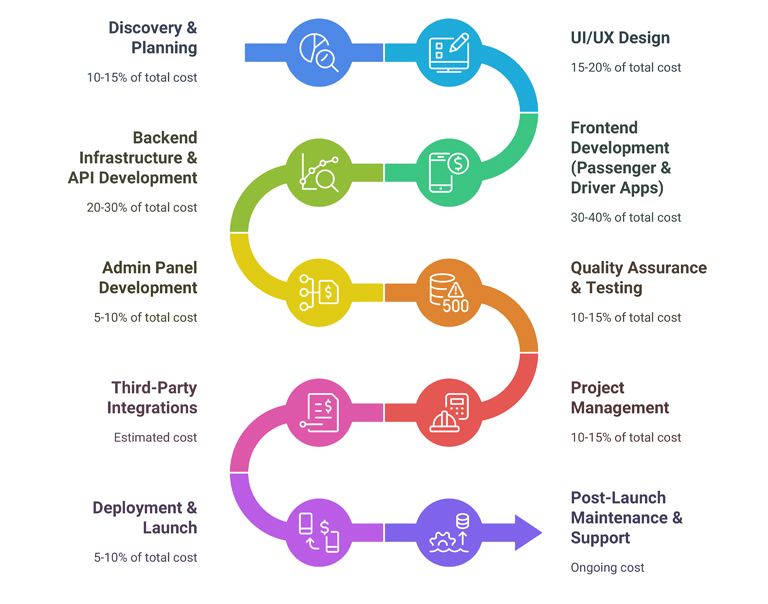
Overall Estimated Cost for a Full-Featured Uber-like App (MVP to Mid-Range):
- MVP (Basic Features): $60,000 – $150,000
- Mid-Range Solution (Enhanced Features): $150,000 – $300,000
- Enterprise-Level (Advanced Features, AI/ML, Scalability): $300,000+
It’s important to note that these are estimates, and a detailed quote can only be provided after a thorough understanding of your specific requirements. Leveraging offshore development teams, like those at Ndimension Labs, can significantly reduce costs while maintaining high quality. For instance, hourly rates in India are often between $25-$50/hr, offering substantial savings compared to Western markets.
How Ndimension Labs Can Help You Build Your Uber-like App
This is where a trusted and experienced development partner like Ndimension Labs comes into play. With a strong track record in delivering cutting-edge mobile and web solutions, Ndimension Labs brings the expertise and dedication needed to navigate the complexities of building a successful ride-sharing application.
Why choose Ndimension Labs?
- Proven Expertise: Ndimension Labs has extensive experience in developing robust mobile applications, including those with complex functionalities like real-time tracking, secure payments, and intricate backend systems. They have a specific case study for a Cab Booking app called MUVZ, demonstrating their direct experience in this domain.
- Comprehensive Service Offering: From initial conceptualization and detailed market analysis to UI/UX design, development (native iOS and Android, and cross-platform solutions like Flutter), rigorous QA, deployment, and ongoing maintenance, Ndimension Labs offers an end-to-end service. This means you have a single, reliable partner throughout your entire app development journey. Explore their full range of services on their Android App Development page and main services
- AI-Powered Development: In 2025, AI is not just a buzzword; it’s a necessity for competitive advantage. Ndimension Labs is an AI-powered mobile apps development company, offering solutions that can integrate features like dynamic pricing, intelligent matching algorithms, and predictive analytics, giving your app an edge.
- Global Presence & Cost-Effectiveness: Headquartered in India with offices in the US, Ndimension Labs provides competitive pricing without compromising on quality. Their Global Project Delivery Model [GPDM] ensures efficient project execution and cost savings. This is a crucial advantage, especially when considering the significant investment required for such an app.
- Client-Centric Approach: Ndimension Labs prides itself on building long-term partnerships. Their flexible engagement models (Fixed Time & Cost, Time & Material, Dedicated Resource Hiring) are designed to cater to diverse client needs, ensuring seamless communication and transparency throughout the development process. With a 4.8/5.0 rating from 300+ clients across various platforms, their commitment to client satisfaction is evident.
- Scalability and Security: Understanding the importance of handling high user volumes and sensitive data, Ndimension Labs focuses on building scalable architectures and implementing robust security measures, ensuring your app can grow with your business and protect user information.
Factors Contributing to Ndimension Labs’ Success
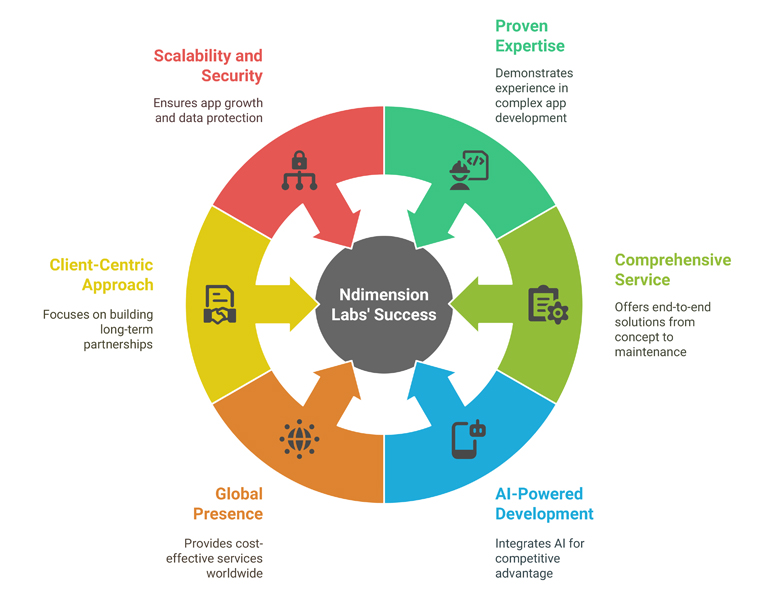
Statistics to Consider:
- Mobile app revenue is projected to reach $613 billion in 2025. (DesignRush) – This highlights the immense market potential you’re tapping into.
- 88% of mobile time is spent in apps, not browsers (DesignRush) – Underscores the critical importance of a well-developed, engaging app.
- Offshore development can reduce overall app development costs by 30-40%. (Various industry reports) – A significant financial benefit of partnering with companies like Ndimension Labs.
Conclusion: Your Journey to a Successful Ride-Sharing App Starts Here
Building an app like Uber is a challenging yet highly rewarding venture. It requires a clear vision, a deep understanding of the market, a meticulously planned development process, and most importantly, a skilled and reliable development partner. By following this step-by-step guide and leveraging the expertise of Ndimension Labs, you can confidently navigate the complexities of app development and bring your innovative ride-sharing technical intricacies deter you. Focus on your unique idea and market understanding, and let Ndimension Labs provide the technological prowess to build a highly functional, scalable, and user-friendly app that not only meets but exceeds user expectations. Ready to take the next step?
Contact Ndimension Labs today to discuss your vision and get a personalized consultation for your ground-breaking ride-sharing application. Your journey to transforming urban mobility starts now!









